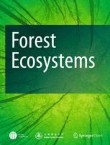Bayesian inference of biomass growth characteristics for sugi (C. japonica) and hinoki (C. obtusa) forests in self-thinned and managed stands
Forests are an important sink for atmospheric carbon and could release that carbon upon deforestation and degradation. Knowing stand biomass dynamic of evergreen forests has become necessary to improve current...
